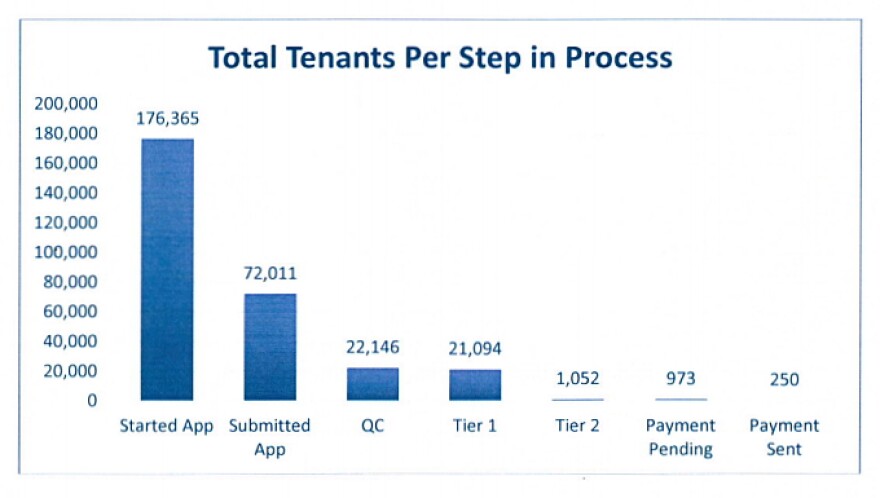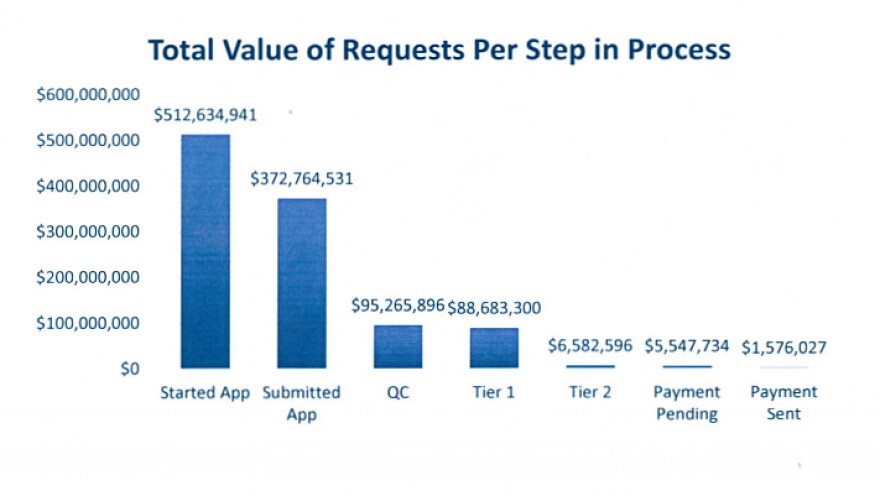A scathing staff report from the Texas House Committee on Urban Affairs released Monday details a host of issues that have plagued the more than $1 billion rent relief program.
“Here we are at the beginning of April and still only about 200 Texas families have actually received direct help from this billion dollar program which is unacceptable and we need to continue to get this worked out quickly,” Rep. Phil Cortez, a San Antonio Democrat who chairs the House Committee on Urban Affairs, told Texas Public Radio.
Faced with a pot of federal money larger than TDHCA’s annual budget, the state agency contracted Houston-based management consultancy Horne LLP to run the Texas Rent Relief program, agreeing to pay the company more than $42 million.
Just as the program launched, the state was hit with the massive winter storm in February, which sidelined a third of the contracted phone operators for days, the report said.
Software problems left the program struggling and spotty, with tenants and landlords complaining of accessibility problems, unanswered phone calls, and “the inability to check the status of an application,” according to the report. A switch to a new software caused system outages and forced applicants to re-apply.
According to the report, of the 176,000 people who have begun applications, just over 1,000 have had their applications approved. And only 250 of payments have been sent.
“It’s people’s lives at stake here, because when evictions happen, their lives are torn apart. They lose their jobs, they lose their health, they have trouble with their relationships, they have trouble getting back on their feet,” said Christina Rosales, deputy director for the advocacy group Texas Housers.
Rosales said she’s heard landlords say at eviction court that they're already so frustrated and tired by the slow pace and confusing nature of rental assistance programs that they’d rather evict tenants than hold out for assistance.
“How are landlords going to have faith in a rental relief program, and how are they going to hang on their tenants, when this is happening?” Rosales said.
When the pandemic hit last year, millions of people across the country lost wages after they were laid off, furloughed or saw work hours cut. Many people, especially women, have been unable to work because of child-care responsibilities. For others, health issues made going to work unsafe while the pandemic raged out of control.
While many have gone back to work, the unemployment rate remains significantly higher than it was before the pandemic.
Exactly how many people have fallen behind on rent over the past year is unclear. Researchers have offered estimates of past-due rent in the U.S. ranging from $8.4 billion to $52.6 billion.
What is clear is that a lot of Texans could use the help of the Texas Rent Relief program.
“We have more than $1 million of unpaid rent dating back to March of last year,” said Ian Mattingly, president of LumaCorp, which manages about 7,000 rental apartments in Texas. “And a large and growing percentage of that is over a year old at this point.”
Mattingly said more than 400 of his company’s residents have tried to apply to the program. After the software glitches, they were asked to re-submit their applications. Of the roughly 200 that have completed applications, only two have been approved for funding.
None have actually received payments.
“This is our third or fourth round of rental assistance for some of these folks, and the documentation process for each round has been different and the application process has been a little bit different,” he said. “And frankly, they’re tired.”
Mattingly also heads the Dallas Apartment Association, which represents landlords.
While he’s cautiously optimistic that the Texas Rent Relief program’s problems have largely been addressed, fundamental questions remain unanswered.
Altogether, about $2 billion of the federal rental and utility assistance funds approved by Congress last year were earmarked for Texas. Most went into the statewide Texas Rent Relief program, and the rest when to city and county governments.
That’s created a confusing patchwork of rental assistance across the state, with rules for how to navigate them still unclear, and it’s forcing landlords into an odd new role.
“We’ve had to handhold our residents through these various processes, obtaining the correct documentation, helping them with scanning,” Mattingly was told by one landlord.
On Wednesday, the head of the Texas Department of Housing and Community Affairs took questions from lawmakers about the troubled rollout of the program. Executive director Bobby Wilkinson said the early days of the program delivered a “bad customer experience for people,” but that the issues are being fixed.
“The application software issue has been resolved. We’re adding added significant resources to attack the backlog and get the money out the door. And we’re also looking for ways to streamline, reduce documentation burdens, and we’ll continue to adapt as needed,” Wilkinson said.
Wilkinson told the House Committee on Urban Affairs that a few hundred more people had had payments sent to them over the past week, and that two additional contractors and hundreds of new analysts were being added to work through the backlog of applications.
“Even now, despite our challenges, we’re ahead of most states in processing applications and making payments,” Wilkinson testified, comparing Texas to other large states like California and Florida.
Wilkinson said many people who tried to apply may need to go back and take extra steps to complete the application.
During the hearing, lawmakers pressed Wilkinson on a number of issues.
He was asked whether he planned to reduce the $42 million contract with Horne LLP due to the troubled rollout, and said his team is “reviewing” the contract.
When asked if he had a set targets for performance going forward, he said “I can and I will,” but that he wanted to for a couple weeks before committing to specific goals.
To a question about whether the application website is mobile-friendly, he replied, “it’s mobile-compatible. I don’t know if it’s great…but you’re supposed to be able to use it on your mobile device.”
Rep. Diego Bernal, a San Antonio Democrat, wanted to know what was being done to make sure landlords know that the problems are being fixed and to urge them to hold off on filing eviction cases against tenants who tried to apply for rent relief but had their application held up .
“All those folks acted in good faith on something that we offered them, that they’re by definition entitled to…and by some sort of error, they’re not getting the relief that they need,” and then the state Supreme Court let its rules around the eviction moratorium lapse, Bernal said.
“Is there any communication that we’re making, saying we messed up, give us a minute and give them a minute so that we can get them the relief that they need, and everyone will be made whole in a few weeks?” Bernal asked.
Wilkinson said he’d be open to exploring more options to get that message out.
KERA also reached out to Gov. Greg Abbott for comment on the report. He oversees the state's executive branch, including the housing and community affairs department. A spokesperson did not respond to the request for comment.
Housing advocates acknowledge the challenges of standing up such a massive program, but Christina Rosales from the group Texas Housers said there’s a larger issue at play here: As a state, Texas regularly fails to focus its vast resources on helping people in the midst of a disaster.
For the past year, housing advocates have been pointing to the slow-rolling housing crisis brought on by the pandemic. The state’s leadership should’ve been prepared to get money out to struggling renters as soon as Congress approved the funding, Rosales said, but instead have focused on their own political interests.
“There’s no excuse,” Rosales said. “We’ve been expecting there to be aid [for renters] for months and months so there should have been a plan in place.”
Even if the program’s software and staffing struggles have been addressed, Rosales still worries that the program’s reliance on online applications will leave eligible renters unable to apply.
Those most affected by the pandemic and its economic devastation – low-wage workers, Black and Latino Texans, and rural communities – are also the least likely to have internet at home.
The report was released less than a week after the Supreme Court of Texas let lapse a set of rules for how courts in the state enforce a federal eviction ban, which the Biden administration extended through into the summer.
Housing experts say they expect expiration of the eviction rules will make the already spotty protections of the eviction moratorium even more unevenly applied. That makes removing barriers to helping families catch up on the rent even more vital, Rosales said.
Texans shouldn’t have to overcome so many bureaucratic and technological challenges just to get help that Congress already funded, Rosales said. She’s impressed by how many do persevere.
“I am amazed at the strength and resilience that these folks have to figure out how to get on the internet, when they don’t have internet at home, and their resourcefulness in getting rent relief at this point,” she said. “It is kind of a miracle that they are able to do it.”
This story has been updated to include testimony from Texas Department of Housing and Community Affairs Executive Director Bobby Wilkinson.
Got a tip? Christopher Connelly is KERA's One Crisis Away Reporter, exploring life on the financial edge. Email Christopher at cconnelly@kera.org.You can follow Christopher on Twitter @hithisischris.
KERA News is made possible through the generosity of our members. If you find this reporting valuable, consider making a tax-deductible gift today. Thank you.
Copyright 2021 KERA. To see more, visit KERA. 9(MDAwMTM1NDgzMDEyMzg2MDcwMzJjODJiYQ004))




